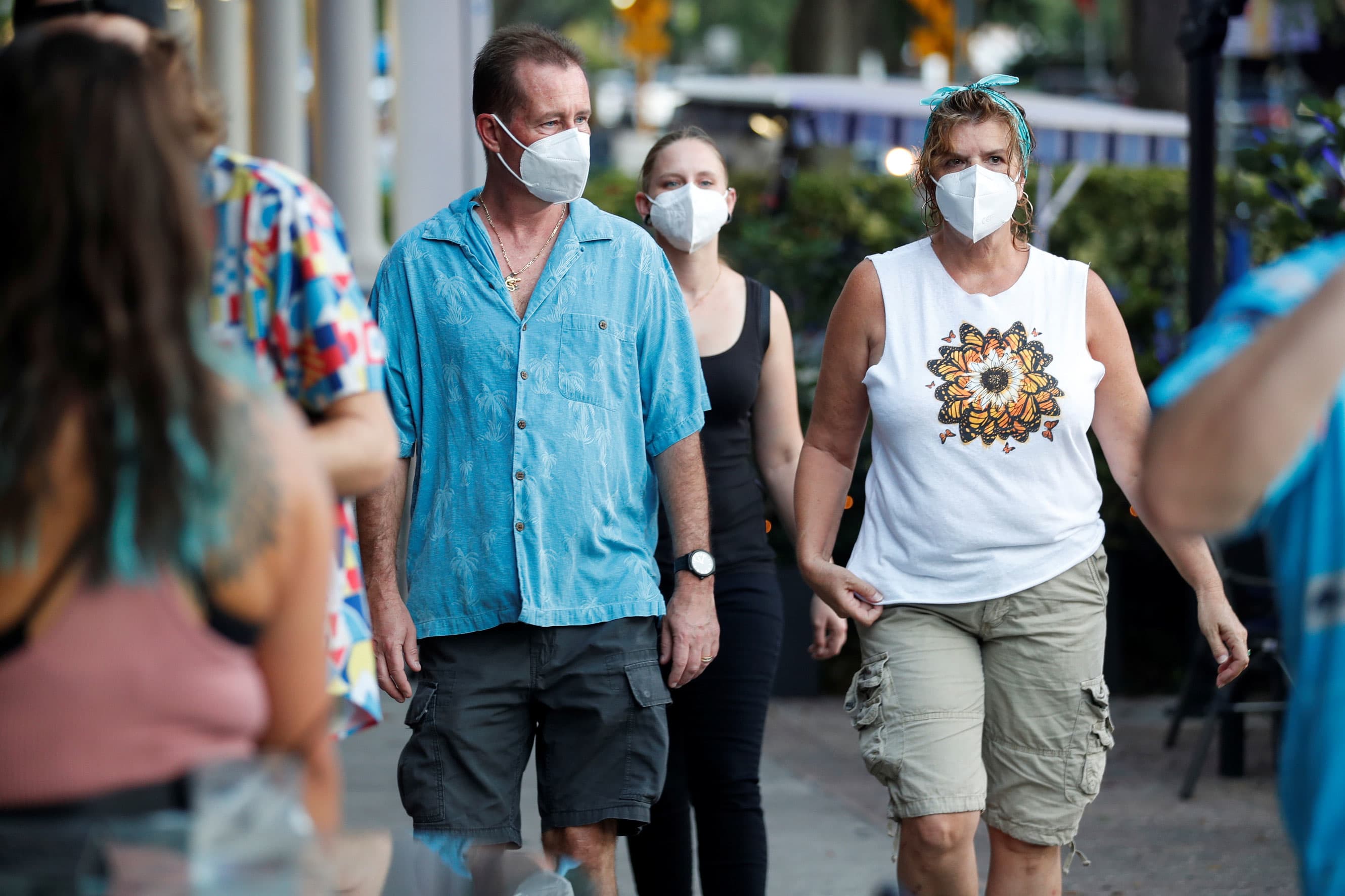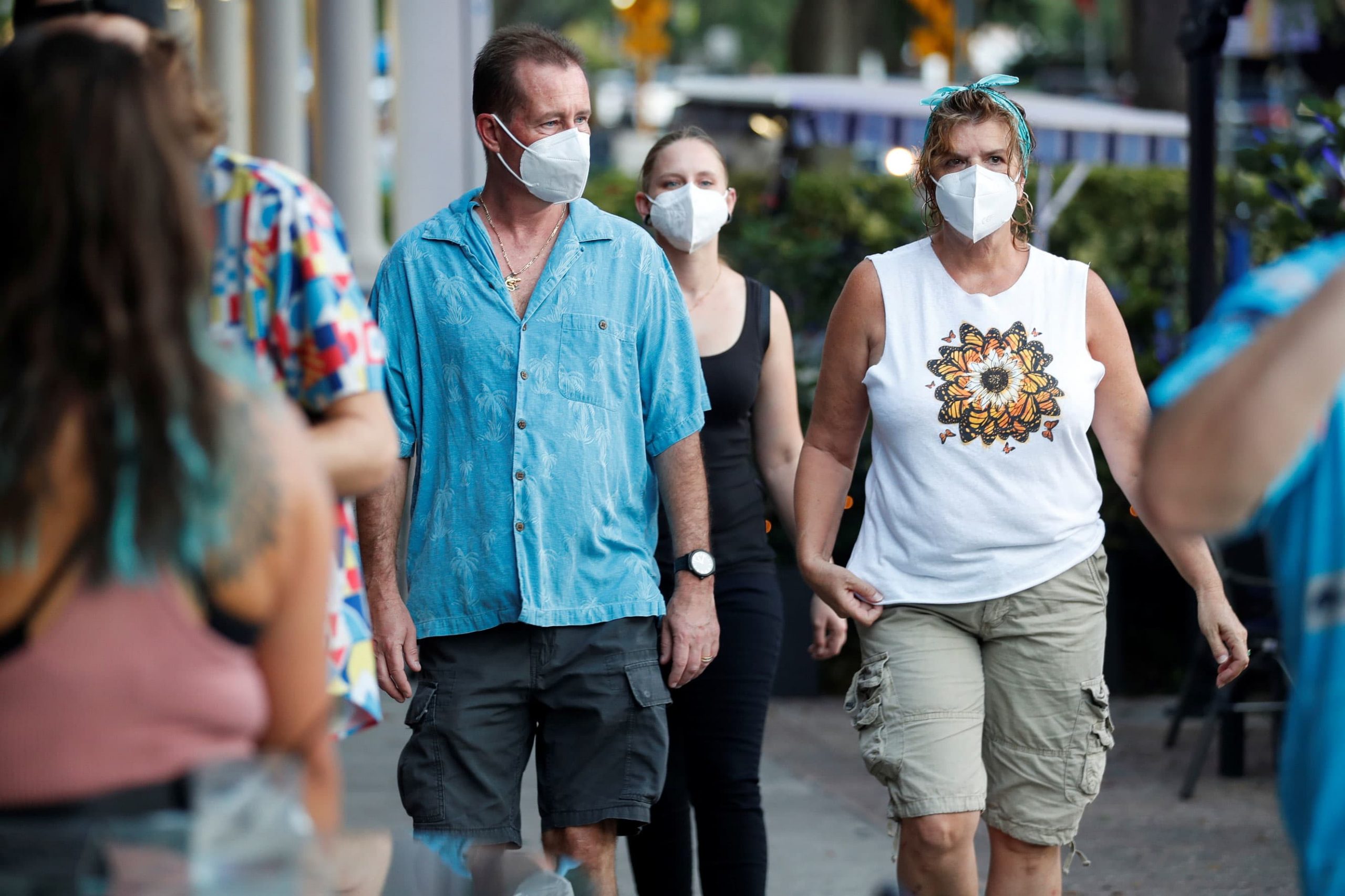
People wearing protective face masks walk in downtown St. Petersburg, amid coronavirus disease (COVID-19) pandemic, in Florida, August 6, 2021.
Octavio Jones | Reuters
If the U.S. recovery is going to progress, it will need the help of efforts to fight the delta Covid variant, and there are signs that the tide might be turning, albeit slowly.
Cases are continuing to rise but at a slower pace. That may not be much comfort with the national rate still around 150,000 a day, but it is giving rise to hope that business and consumer activity can keep the economy on track toward pre-pandemic levels.
“The percent increases in cases and hospitalizations are declining each week, indicating progression towards a nationwide peak,” Chris Meekins, health policy research analyst at Raymond James, said in a note. “While a few days later than predicted, the Southern states that were initially hardest hit by the delta variant appear to be peaking or have peaked.”
By Meekins’ count, the rate of increase for cases has slowed to 11.7% while the level for hospitalizations is at 14.7%, well below their respective totals of 32% and 37% two weeks ago.
At the same time, metrics for the economic reopening continue to improve, though also at a slower pace as the rise of delta has raised concern about what lies ahead.
A look at mobility
Google Mobility data helps underscore the uneven nature of the recovery as well as the slow but steady path higher.
As of Aug. 17, the numbers for recreation showed continued strong gains, though they were well off their peaks. Mobility for parks, beaches and other public areas was up 31% from the five-week period prior to mid-February 2020, less than a month before the official pandemic declaration.
By contrast, workplace mobility was still well off the pace, down 33% from pre-pandemic levels, while transit stations were seeing 23% less traffic. Retail and recreation also remain a shade below, while grocery and pharmacy activity has resumed to a bit above.
A tracker that Jefferies has been using to gauge how close the economy is to pre-Covid levels has been hovering near 100% for the past several weeks, and even briefly touched that barrier in late July.
Delta is “having an impact, we have to acknowledge that. I wouldn’t call it significant. I think it’s moderate and in many cases very localized,” said Aneta Markowska, chief financial economist at Jefferies. “It’s really just causing a loss of momentum rather than pronounced economic weakness, and there is good chance that it will be pretty short-lived.”
Indeed, many medical professionals see delta peaking sometime in the fall, though estimates vary.
Through Friday, the Jefferies tracker is seeing activity at 99% of “normal,” with foot and retail web traffic among the metrics back above pre-pandemic levels, while transit was at just 70.3% and international flights are at a mere 56.4%.
As for delta, the numbers, like those of the pandemic, are still worrisome but moving in the right direction.
Fundstrat research head Tom Lee’s latest look at the data overnight Monday shows that some of the states that had the worst delta bursts are now seeing a decline in case growth as well. They include California, Nevada, Florida, Louisiana, Arkansas, Maine, Rhode Island and Delaware. There are nine other states that look “tentatively flattening” in their numbers, including New Hampshire, South Dakota and Washington.
“We will have a better sense for these states in the coming days,” Lee said. “But the key takeaway, to me, is that even with the delta variant, states are not going to see cases surge indefinitely. There is a peak.”
Worries are persisting
Still, policymakers and economists are showing concern that delta could have a larger impact than thought.
Goldman Sachs last week took down its projection for third-quarter GDP growth to 5.5%, all the way from 9%. Also, the Federal Reserve on Friday said it would move its annual Jackson Hole symposium this week to an all-virtual event in light of virus issues in Wyoming.
Yet the Fed is likely to start pulling back this year on its policy accommodation, and 5.5% is still powerful growth.
Both the economic and virus numbers paint a picture of a choppy recovery, but one that is nonetheless progressing.
“The Delta variant likely further slows the rebound, as firms and employees back away from returning-to-office this fall,” wrote Steve Blitz, chief U.S. economist at TS Lombard. “Delta consequently extends this drop-off in growth to be followed by a synchronized global recovery that ultimately outperforms the expansion of the prior ten years — at least for the US. To be clear, slower growth now is just that — a recovery is still underway.”
Become a smarter investor with CNBC Pro.
Get stock picks, analyst calls, exclusive interviews and access to CNBC TV.
Sign up to start a free trial today.


 Signal2forex.com - Best Forex robots and signals
Signal2forex.com - Best Forex robots and signals




